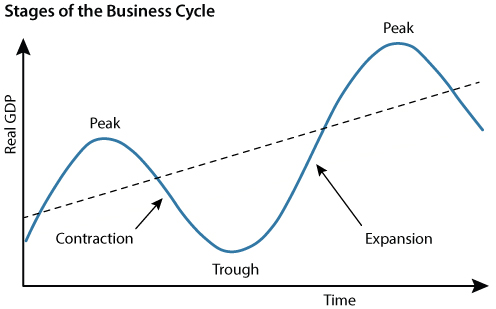- English
- 简体中文
- 繁体中文
- ไทย
- Tiếng Việt
- Español
- Português
- لغة عربية
Analysis
At its core, the business cycle refers to the fluctuations, at a broad level, between economic expansion, and contraction, helping to define the overall state of the economy at a given time. Many indicators can be used in an attempt to time the economic cycle, including - GDP, interest rates, employment, and spending.
Typically, the business cycle is split into the four stages below. However, it is important to note that no two cycles are identical; the length of expansions has varied wildly over time, as has the length of recessions/depressions, while the amplitude of the peaks and troughs in the cycle also varies over time.
Cycle Stages
- Expansion: During this phase of the cycle, the economy experiences a rapid pace of growth, with interest rates tending to be relatively low, as output increases across most parts of the economy. Employment tends to increase, and earnings - as well as corporate profits - begin to trend higher. This rise in earnings, coupled with an increase in the money supply, does however pose the risk of spurring higher inflation as the economy expands.
- Peak: The cycle’s peak is seen when growth hits its terminal velocity, a point at which various indicators of prices and economic output typically experience a period of stability, before correcting to the downside. This stage of the cycle often creates imbalances between supply and demand (of goods, services, and/or labour) which must ultimately be corrected.
- Contraction: The opposite phase to an economic expansion, and one where growth slows, employment falls, and prices either stagnate or decrease. Often, businesses are slow to adjust to such a contraction, leading to a surplus in supply of goods and services as demand deteriorates, contributing to the aforementioned downward pressure on prices. A contraction is often defined as a recession, technically only if it results in two consecutive quarterly contractions in GDP growth, and may deteriorate further into a depression if it becomes prolonged.
- Trough: The cycle’s trough is when economic growth bottoms out before an eventual recovery begins to take hold. This is the worst moment of the cycle for the economy, where spending and income are at their lowest level, and the labour market has dramatically weakened, with hiring coming to a halt, and unemployment having risen substantially. Following a trough, the economy will begin to recover, and re-enter the expansion phase.
A graphical representation of this cycle can be found below, courtesy of the St Louis Fed:

Related articles
The material provided here has not been prepared in accordance with legal requirements designed to promote the independence of investment research and as such is considered to be a marketing communication. Whilst it is not subject to any prohibition on dealing ahead of the dissemination of investment research we will not seek to take any advantage before providing it to our clients.
Pepperstone doesn’t represent that the material provided here is accurate, current or complete, and therefore shouldn’t be relied upon as such. The information, whether from a third party or not, isn’t to be considered as a recommendation; or an offer to buy or sell; or the solicitation of an offer to buy or sell any security, financial product or instrument; or to participate in any particular trading strategy. It does not take into account readers’ financial situation or investment objectives. We advise any readers of this content to seek their own advice. Without the approval of Pepperstone, reproduction or redistribution of this information isn’t permitted.







